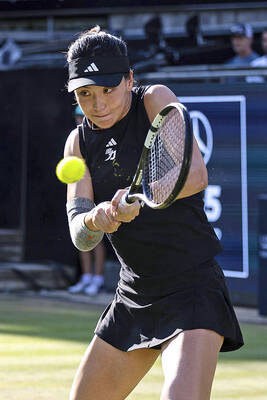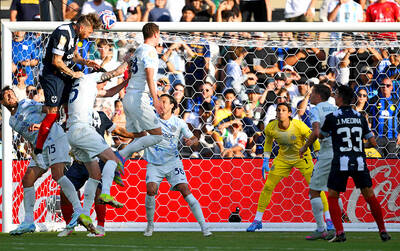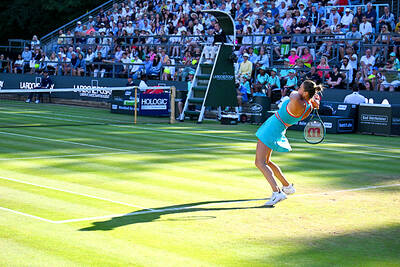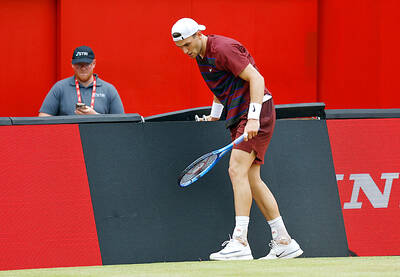Miami Dolphins running back Ricky Williams returns tomorrow after a four-game suspension for violating the National Football League's substance-abuse policy, the latest of several cases involving the NFL that raise questions for all sports about what drug testing can reasonably be expected to accomplish.
While Congress has heavily criticized Major League Baseball for its drug-testing policy, those same lawmakers have praised the NFL, whose program is regarded by drug experts as the best among professional sports leagues in the US.
Still, about seven players a year fail the NFL steroids test, a number that is comparable to the 10 players who failed baseball's steroids test in the first year of its new drug-testing policy.
This season, the rookie fullback Rick Razzano of Tampa Bay was suspended for four games for failing a steroids test, and Vikings running back Onterrio Smith was suspended for a year after he was caught with a Whizzinator, a mechanism designed to subvert urine tests.
The NFL also investigated three players -- center Jeff Mitchell of Carolina, tackle Todd Steussie of Tampa Bay and punter Todd Sauerbrun of Denver -- after CBS News reported in March that they had filled prescriptions for steroids that were written by a doctor in South Carolina who has been indicted on federal charges. None of the three tested positive under the NFL's program, and the players have not been suspended, but they will be subject to an increased number of random tests in the coming years. All three players were playing for the Panthers when they saw the doctor.
On Thursday, the Web site for "60 Minutes" reported that Bill Romanowski, a former linebacker for the Broncos, admitted in an interview to be broadcast Sunday that he took steroids from spring 2001 until fall 2003, and that he got them from Victor Conte, founder of the Bay Area Laboratory Co-Operative.
"I think the fact that we still have some positives, in some ways I think that is sort of an inevitable reality," said the NFL's executive vice president, Jeff Pash, in a recent interview. "There will be some people who will try to get an edge. But the fact that we have some positives I think suggests that it is quite difficult to get that edge and that the odds are that those efforts will be detected.
"I'm not so naive as to say that we will get to the point where there is complete absence of any illegal substances."
The NFL has twin programs. One tests for performance-enhancing drugs, like steroids, and one tests for substance-abuse drugs, like marijuana and cocaine.
Since testing began in 1989, 57 players have been suspended for steroids, and there have been 60 more positive tests -- many in training camp -- on players who either retired or were released before their suspensions were announced. That is a total of 117 positive steroid tests in 16 years, or about seven a year. There have been just two repeat positives by an individual player in the steroids program. The policy currently calls for a player to be suspended four games for a first positive test for steroids.
The NFL recently lowered the threshold for the level of steroid necessary to trigger a positive test. Had the threshold been lowered earlier, more players taking small amounts of steroids might have been caught.
"It's clear that the program is adaptable to deal with changing circumstances," said Doug Allen, the assistant executive director of the NFL Players Association. "This is an arms race, and it's never going to be over. Testers are always going to be sprinting to catch up to those that would avoid and evade testing. That's a given."
There have been 165 publicly announced suspensions for substance-abuse violations, including several repeat offenders. Under the rules, players are not suspended for a first substance-abuse violation the way they are for performance-enhancing drugs. Williams was suspended because he tested positive for marijuana several times.
Many players are in the league's substance-abuse program, most of them anonymously, because of one positive test or an incident, like a drunken driving arrest. Subsequent positive tests lead to suspensions and fines.
"The NFL is ahead of the pack, I do believe that, but there's a lot of buts," said Dr. Gary Wadler, a New York University professor and a member of the World Anti-Doping Agency.
Among them:
* Wadler wants the NFL to adopt WADA's exhaustive list of banned substances, which is compiled with input from sports governing bodies worldwide and is much more far-reaching than the NFL's list. For example, Wadler said the NFL should categorize amphetamines as performance-enhancing drugs. Amphetamines are currently considered a violation of the substance-abuse policy, which imposes lesser penalties. The NFL and the players association contend that a one-size-fits-all list won't work, because there are many sport-specific drugs and practices -- for example, those that boost the endurance of long-distance cyclists -- that are irrelevant in football.
* Wadler believes the NFL should farm out its drug testing to an independent body, as the Olympics does, both to avoid the appearance of conflict of interest (the league office also hears and decides all appeals) and to keep up with the science of doping.
* Wadlers believe the process should be more open to the public, especially after a player's case is decided. He wants the type of drug detected made public, arguing that it would help educate those who are charged with cleaning up sports.
"They, too, will come to the realization that no matter how earnest they are, they're going to have the problems the Olympics have had of perception, and that's the court of last resort: What do people think?" Wadler said.
That is already a struggle with the substance-abuse policy. With a wink and a giggle, some players confess to using drugs. Oakland Raiders receiver Randy Moss said in a recent television interview that he smokes marijuana occasionally.
Williams has admitted that he has failed drug tests and last year, after he retired, he created a fire-storm when he told Sports Illustrated that some players drink a masking agent to hide marijuana use before tests.
There are stipulations in the drug-testing policy about diluted samples, an effort to stop players from using masking agents. There is a strict protocol for how urine samples are obtained: a monitor watches as a player -- with no shirt on, and pants dropped to his ankles -- urinates. It is intrusive, embarrassing and, the league believes, virtually cheat-proof. Still, as much of a deterrent as such a scene might seem, everyone acknowledges that those who are determined to use drugs to cheat -- or who want to use them recreationally -- will convince themselves they can get away with it.
"I have four F's for why athletes use drugs: fame, fortune, free time and a feeling of invincibility," Wadler said.
"They push the envelope and think they will avoid being detected and believe they will never get sick. That's the makeup of an athlete, their sense of invincibility."
Redskins tackle Ray Brown believes that the randomness of the tests -- and especially the threat of significant fines -- is a deterrent for most players.
Brown remembers the Redskins' trainer tapping him on the shoulder to alert him to another drug test so often in 1992 that he became convinced the NFL had it in for him.

Twelve days after winning her second Grand Slam title at the French Open, Coco Gauff fell at the first hurdle on grass in Berlin on Thursday as beaten Paris finalist Aryna Sabalenka advanced to the quarter-finals. Recipient of a first round bye, American Gauff lost 6-3, 6-3 to Chinese qualifier Wang Xinyu as world number one Sabalenka beat Rebeka Masarova 6-2, 7-6 (8/6) in her second round tie. Winner of 10 main tour titles, including the US Open in 2023 and the WTA Finals last year, Gauff has yet to lift a trophy in a grass-court tournament. “After I won the first

Sergio Ramos on Tuesday outfoxed two Inter players and artfully headed home the first goal for Monterrey at the FIFA Club World Cup. The 39-year-old Ramos slipped through the penalty area for the score just as he did for so many years in the shirts of Real Madrid and Spain’s national team, with whom he combined smarts, timing and physicality. Ramos’ clever goal and his overall defensive play at the Rose Bowl were major factors in Monterrey’s impressive 1-1 draw against the UEFA Champions League finalists in the clubs’ first match of the tournament. “There is always a joy to contribute to the

Top-ranked Aryna Sabalenka staged a “crazy comeback,” saving four match points before beating Elena Rybakina 7-6 (6), 3-6, 7-6 (6) in the quarter-finals of the Berlin Open on Friday. Sabalenka was 6-2 down in the final-set tie-breaker, but won six straight points to reach her eighth semi-final of the season. “Elena is a great player and we’ve had a lot of tough battles,” Sabalenka said. “I have no idea how I was able to win those last points. I think I just got lucky.” “I remember a long time ago when I was just starting, I won a lot of matches being down

While British star Jack Draper spent the past week trying to find rhythm and comfort in his first grass tournament of the season at the Queen’s Club Championships in London, Jiri Lehecka on Saturday bulldozed everything in his path. After more than two furious hours of battle, their form was reflected in the final scoreline as Lehecka toppled a frustrated Draper, the second seed, 6-4, 4-6, 7-5 to reach the biggest final of his career, against Carlos Alcaraz. Lehecka is also the first Czech to reach the men’s title match at Queen’s since Ivan Lendl lifted the trophy in 1990. Draper, who